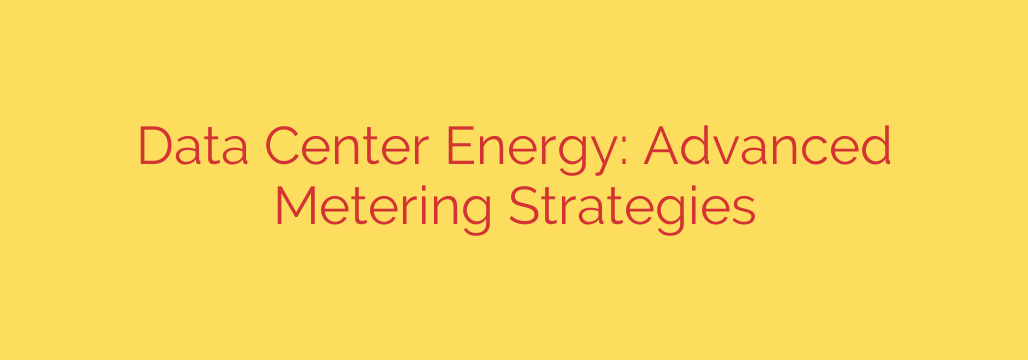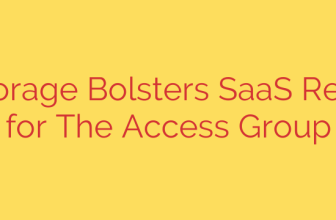
Mastering Data Center Energy: Your Guide to Advanced Metering Strategies
In the world of data center management, energy consumption isn’t just an operational detail—it’s a critical factor that impacts everything from budget allocation to environmental responsibility. As energy costs continue to rise and sustainability becomes a top corporate priority, simply paying the utility bill is no longer a viable strategy. To truly optimize performance, data center operators must move beyond basic monitoring and embrace the power of advanced energy metering.
Gaining control over your facility’s power usage requires a shift in mindset: from seeing a single, massive energy bill to understanding consumption at a highly detailed level. This granular view is the key to unlocking significant efficiency gains, reducing operational expenses, and future-proofing your infrastructure.
Why Traditional Power Monitoring Falls Short
For years, the primary tool for measuring data center efficiency has been Power Usage Effectiveness (PUE). While PUE is an excellent high-level metric for comparing the total facility power to the IT equipment power, it doesn’t tell the whole story. Relying solely on data from the main utility meter is like trying to diagnose a patient’s illness with only their body temperature—it indicates a problem but offers no insight into the cause.
Without a more detailed approach, managers are left with critical blind spots. It becomes impossible to accurately answer questions like:
- Which server racks are drawing the most power?
- Is my cooling system operating at peak efficiency?
- Do I have “ghost servers” consuming power while performing no useful work?
- How can I accurately bill individual clients or departments for their specific energy use?
This lack of visibility leads to over-provisioning, wasted energy, and missed opportunities for cost savings.
The Power of Granularity: What is Advanced Energy Metering?
Advanced energy metering is the practice of deploying sub-meters throughout the data center’s power chain. Instead of one data point, you get hundreds or even thousands, providing a precise, real-time map of where every kilowatt is going.
This strategy involves collecting data at multiple critical points:
- At the Rack Level: Intelligent Power Distribution Units (iPDUs) provide outlet-level metering, showing the exact consumption of each server, switch, or storage device.
- At the Row or Zone Level: Branch Circuit Monitoring Systems (BCMS) installed in panelboards and power distribution panels track the energy usage of entire rows of racks or specific zones.
- In the Power Chain: Meters on Uninterruptible Power Supplies (UPS) and Power Distribution Units (PDUs) help differentiate between the IT load and the power consumed by supporting infrastructure like cooling systems.
By capturing this highly granular data, you can move from reactive problem-solving to proactive, data-driven optimization.
Key Benefits of an Advanced Metering Strategy
Implementing a robust metering system provides tangible benefits that directly impact both the bottom line and operational resilience.
Dramatically Reduce Operational Costs: The most immediate benefit is identifying waste. By pinpointing underutilized or comatose servers, you can consolidate workloads and decommission unnecessary hardware, leading to direct savings in power, cooling, and maintenance. Granular data also enables accurate chargeback models, ensuring business units or tenants pay for what they use.
Optimize Power Usage Effectiveness (PUE): Advanced metering is essential for improving your PUE score. By precisely measuring the IT load versus the power used by cooling and other support systems, you can identify inefficiencies in your cooling strategy. For example, you might discover that a specific hot aisle requires more targeted cooling, allowing you to reduce overcooling in other areas.
Enhance Capacity Planning: Guesswork in capacity planning leads to expensive over-provisioning. With accurate, real-time data on power usage at the rack level, you can confidently deploy new equipment without risking tripped circuits. This data-driven approach maximizes the use of your existing infrastructure and helps you forecast future power and space requirements with far greater accuracy.
Support Sustainability and ESG Goals: Corporate sustainability is no longer optional. Advanced metering provides the verifiable data needed for Environmental, Social, and Governance (ESG) reporting. Demonstrating measurable improvements in energy efficiency strengthens corporate reputation and meets regulatory requirements.
Improve Uptime and Reliability: Power anomalies can be early warning signs of equipment failure. By monitoring for unexpected spikes or drops in power consumption at the device level, you can proactively identify failing power supplies or other hardware issues before they cause an outage, significantly boosting overall facility resilience.
Actionable Steps to Implement Your Metering Strategy
Transitioning to an advanced metering system is a strategic project that requires careful planning.
- Conduct a Comprehensive Audit: Begin by mapping your existing power chain and identifying your current monitoring capabilities. Understand where your biggest knowledge gaps are.
- Define Clear Goals: Determine what you want to achieve. Are you focused on reducing OpEx, improving PUE, enabling a chargeback system, or all of the above? Your goals will dictate the level of granularity required.
- Select the Right Hardware: Invest in modern, intelligent PDUs (iPDUs) and Branch Circuit Monitoring Systems. For facilities using busway power distribution, ensure tap-off boxes are equipped with integrated monitoring.
- Integrate with DCIM Software: The raw data from meters is only valuable when it’s centralized and analyzed. A Data Center Infrastructure Management (DCIM) platform is crucial for visualizing energy trends, generating reports, and setting automated alerts. This software turns data into actionable intelligence.
- Analyze, Act, and Iterate: The process doesn’t end with installation. Regularly review the data to identify trends and anomalies. Use the insights to make informed decisions—from decommissioning a server to adjusting a thermostat—and continuously track the impact of your changes.
In today’s competitive landscape, data-driven decision-making is paramount. By embracing an advanced energy metering strategy, data center managers can take firm control of their power consumption, transforming a major operational expense into a powerful strategic advantage.
Source: https://datacenterpost.com/powering-the-future-behind-the-meter-solutions-for-data-centers/








